The Best Things To Do in Lagos

Lagos is a pretty coastal town on the Algarve Coast that has it all: nature, beaches and historical architecture. The beautiful nature of Lagos is perfect for hikes along the cliffs and capturing the interesting rock formations from every angle. Lagos’ charming city center is filled with colorful historical buildings, making it a lovely place to stroll around. When you’re done exploring the nature and historical town, there are plenty of opportunities to relax at one of the many beaches in Lagos. Some of these beaches are perched between rock formations, offering the best views while going for a swim in the Atlantic Ocean. In this blog post, we’re sharing the best things to do in Lagos so you can make the most out of your visit to this lovely coastal town.
History of Lagos
The history of Lagos is rich and diverse, spanning more than 2000 years. The city’s strategic coastal location in the southern region of the Iberian Peninsula has made it an important center for trade and exploration. After Roman rule, Lagos was occupied by the Moors in the 8th century. The Moors fortified the town with city walls and a castle nowadays known as the Castle of Lagos. Parts of the old city walls are still up today.
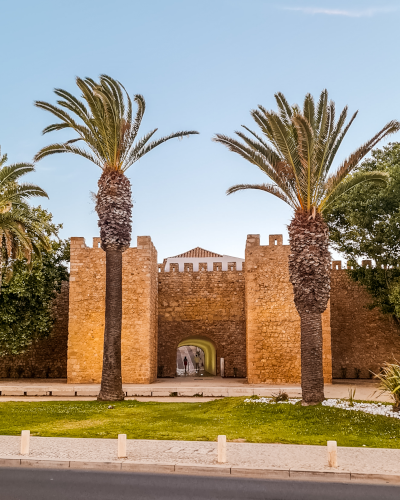
The Castle of Lagos, which is basically a gate through which you can walk to enter the historic city center of Lagos.
In the 13th century, Lagos was captured by King Afonso II of Portugal. During the Age of Discovery in the 15th century, Lagos became the center of Portuguese maritime exploration. Lagos also became a gateway for slaves and in 1444 the first slave market opened in Lagos. In 1755, the great earthquake and tsunami destroyed most of Lagos. Only some of the city walls and the Castle of Lagos still remain. Most of the buildings in Lagos’ city center are from the 17th century.
Historic city center
Due to its rich history, Lagos is one of the most charming towns on the Algarve Coast. We can highly recommend strolling through the many streets and admiring the historical buildings.
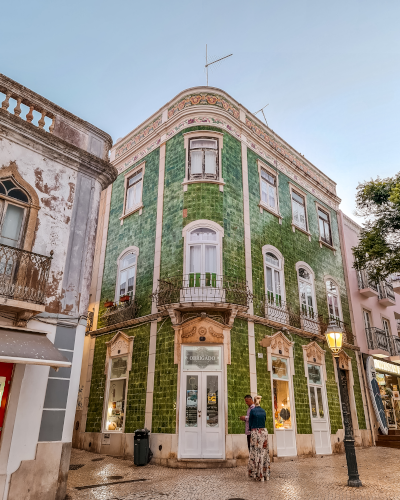
Green building on Praça Luís Camões
Igreja de Santo António and Museum of Lagos
Igreja de Santo António is a church constructed in 1707 and rebuilt in 1769. The interior looks impressive, with gilded wood works considered to be one of the most beautiful gilded wood works in Portugal. The church is connected to the Museum of Lagos. The museum is dedicated to the history of Lagos and showcases a collection of historical items from different ages. As both buildings are connected for visitors, you can only visit the church by buying a ticket for the museum and vice versa.
Opening hours:
Tuesday - Saturday: from 10:00 until 13:00 and from 14:00 until 18:00
An entrance ticket for the church and the museum is €3.
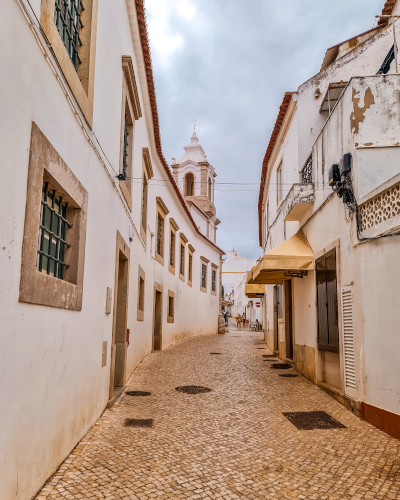
Streets of Lagos with a tower of Igreja de Santo António in the background
Slave Market
The Mercado de Escravos, or Slave Market, is the name of a building located on the site where the first slave market in Europe in 1444 took place. The building that stands there today was constructed in 1691 and was used for military administration purposes and later as the Customs House for Lagos. Nowadays, there’s a museum in the building that’s dedicated to the story of slavery in Portugal, providing historical context and insight into the atrocities of the slave trade.
Opening hours:
Tuesday - Sunday: from 10:00 until 13:00 and from 14:00 until 18:00
Closed on Mondays.
An entrance ticket is €3.
Fort of Ponta da Bandeira
The Fort of Ponta da Bandeira is a fort dating back to the 17th century and is located along the coast of Lagos, next to Praia da Batata. The fort served as a defense against pirates and enemy attacks. When the construction of the fort was finished, it was considered one of the most advanced in the Algarve region. In 1755, the fort was badly damaged by an earthquake and was restored after that. The municipality of Lagos bought the fort at the end of the 1970s and opened it to the public for visits against a small fee. However at the time of writing this blog post, the fort unfortunately isn’t open to visitors anymore. It’s still possible to admire the fort from outside.
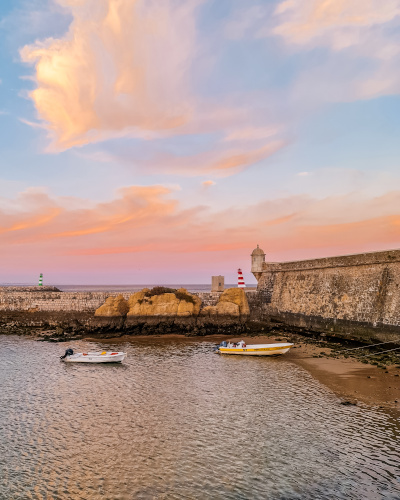
Forte de Ponta da Bandeira
Praia da Batata
Praia da Batata is the beach that’s closest to the historic city center of Lagos. This beach also marks the start of the coastline with impressive rock formations. You can witness the first rock formations from here. Praia da Batata is a relatively large beach, but due to its proximity to the city center it’s also one of the most crowded ones. Nevertheless, it’s absolutely worth checking out this beach when you’re in Lagos. Especially, during sunset the rock formations are an impressive sight.

Praia da Batata during sunset
Lagos Cliff Walk
Praia da Batata also marks the start of the Lagos Cliff Walk, a trail that goes past the coastline from the city center of Lagos to the most southern point of Ponta da Piedade. The path is made of wooden boardwalks that mostly don’t go near the cliffs. However, you can hop off the wooden boardwalk whenever you see a beautiful view to get closer to the cliff. Be careful to not get too close to the edge as the cliffs could be unstable. The Lagos Cliff Walk is around 3 km long one way and should take about 30 minutes walking at a leisurely pace. The trail is very easy without any inclinations. The Lagos Cliff Walk goes past all the beautiful beaches of this coast line.
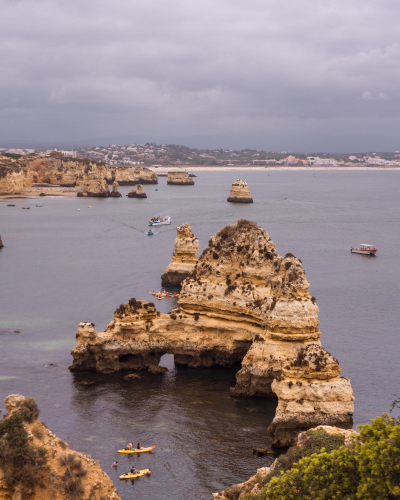
The view of the impressive rock formations somewhere along the Lagos Cliff Walk
Praia dos Estudantes is a beach that’s famous for its unique Roman style arch bridge that connects two rock formations to each other. The bridge is a remnant of the fortress of Pinhão. It’s not possible to access the bridge and the rock formations. You can reach Praia dos Estudantes by getting down the stairs next to Mar Restaurant on top of the cliffs or from the tunnel on the southern end of Praia da Batata. Praia dos Estudantes is made of two small beaches that are connected to each other by a small tunnel. You can see the Roman style bridge from the most southern part of the beach, so you have to get through the tunnel to see it.

Praia dos Estudantes
Praia Dona Ana is one of the largest beaches on the coast line. You can reach the beach by getting down the stairs in front of the parking area. Don’t forget to admire the view from the top of the cliffs as it’s beautiful too.
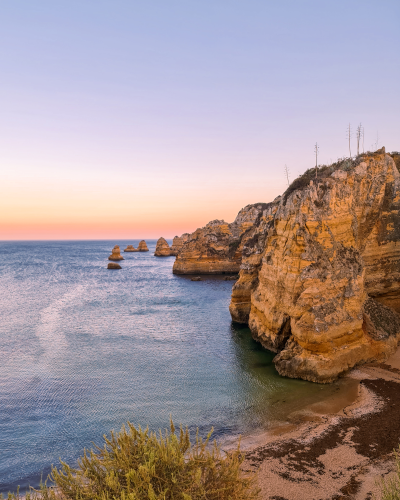
Praia Dona Ana as seen from the top of the cliffs
Once down at the beach, you can see the tall and impressive rock formations from a lower perspective. We can imagine this beach would look very inviting during the day, but we’ve only been there in the evening. If you’re planning on going during the day, don’t forget to bring your swimwear so you can take a dip in the Atlantic Ocean and swim around the rock formations.
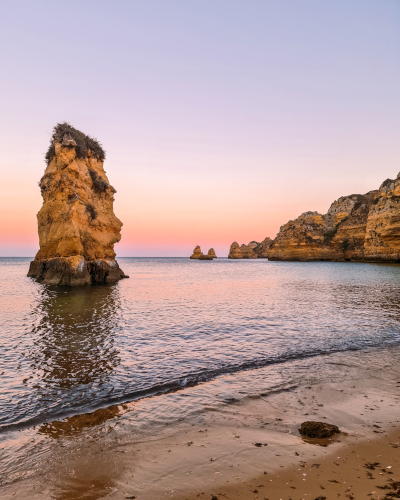
Praia Dona Ana
Praia do Camilo is the next beach you’ll reach when walking the Lagos Cliff Walk. Praia do Camilo is a small beach but from the top of the stairs you have an impressive view of the rock formations. It’s especially beautiful during sunset when the sky turns into beautiful hues.
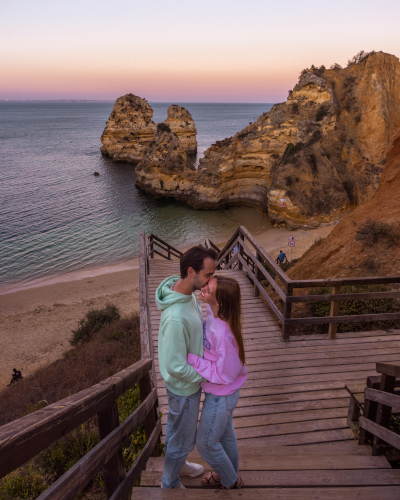
Praia do Camilo
Ponta da Piedade
Ponta da Piedade is one of Lagos’ most famous sightseeing spots. Ponta da Piedade is the most southern tip of Lagos and from here you have an amazing view of the incredible rock formations that surround this point. It also marks the end (or the beginning) of the Lagos Cliff Walk. There’s a small, but sketchy path that you can take to get closer to the edge of the cliffs. Be very careful though when taking this path. Especially during high season it’s way too crowded on this small path and some people are getting way too close to the edge. We’d highly recommend never getting close to the edge as the cliffs can be unstable, which can lead to very dangerous situations.
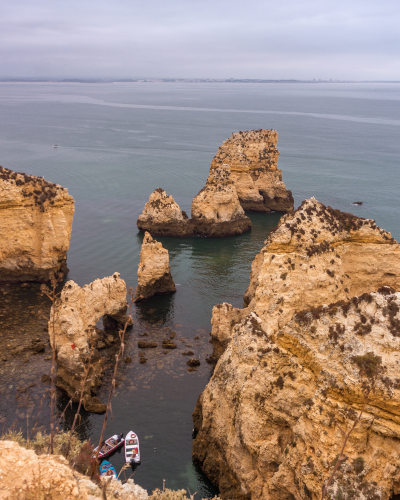
The rock formations from Ponta da Piedade
We decided to fly the drone here too, but it wasn’t a good idea. Our drone got attacked by aggressive seagulls so we just quickly took some shots and then we were luckily able to safely land it. Despite the seagulls, we were able to get an impressive photo of the rock formations from above. We have no idea whether the aggressive seagulls are a seasonal thing or maybe they’re always like this. We can imagine that people fly drones there regularly and that the seagulls are done with it.

Aerial view of Ponta da Piedade
There are stairs that lead down to the water, from where you can admire the rock formations from a lower point of view.
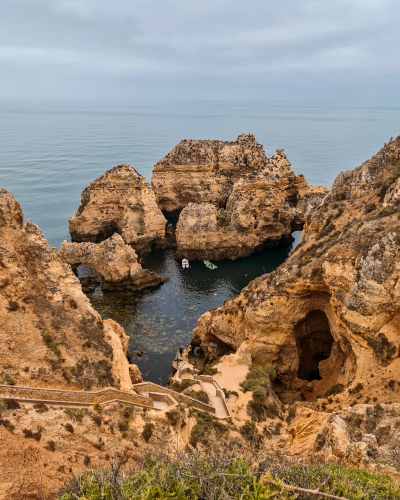
Stairs at Ponta da Piedade
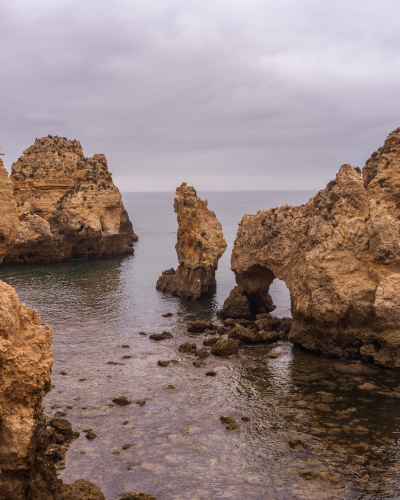
View of Ponta da Piedade from down the stairs
From down the stairs, you’ll see a lot of boats passing by. You can also see the rock formations of Ponta da Piedade from the water by going on a boat tour or a kayak tour. By going on a boat or kayak tour you can also see the grottos here, which are only accessible from the water. We didn’t do a boat or kayak tour here, but we can imagine that it’s very impressive to see it from the water.
Where to stay in Lagos
The town of Lagos isn’t too big, so it doesn’t really matter where you stay (especially if you have a car available). However, if you want to experience the best of Lagos, the best area to stay in would be near the historic center. This way you’re not only close to the shops and restaurants, but you’re also close to the cliffs and the beaches of Lagos. If you’re looking for accommodation in the historic center of Lagos, always make sure to read the reviews. Especially in the high season, the historic center is flooded with tourists and some streets are bustling in the middle of the night. We wouldn’t want to sleep near a street like that, so keep that in mind.
Click here for accommodation in Lagos.
Another option is to stay nearby Lagos and visit Lagos from there, as well as other places on the Algarve Coast. We stayed in Salema, a small village on the coast with a big stretch of fine sand. Salema is a quiet village with a few shops and restaurants, but it has everything you need. Salema is a 30-minute ride away from Lagos by car.
Click here for accommodation in Salema.
Another option is staying in Burgau. Burgau is closely located to Salema and it’s a 20-minute drive away from Lagos. We completely fell in love with this charming and picturesque village. Burgau too is a quiet village with a few shops and restaurants, but the entire village with the white washed houses is so pretty. Burgau also has a nice stretch of beach, although the beach in Burgau is smaller than the beach in Salema.
Click here for accommodation in Burgau.
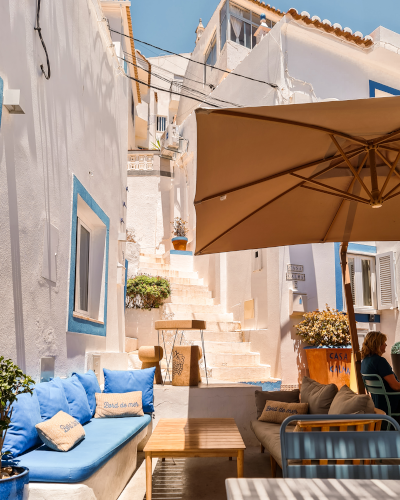
The pretty village of Burgau
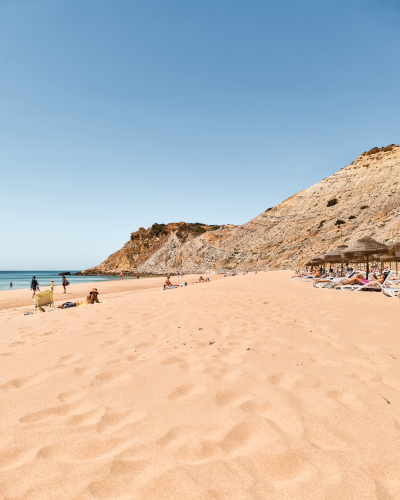
The beach in Burgau
How long to stay in Lagos
If you want to experience the history and beautiful nature of Lagos, two full days is more than enough. However, if you want to spend some time relaxing at the beach, you might want to stay a few days longer. Lagos is closely located to other amazing places on the Algarve Coast, such as Benagil, Sagres and Burgau. You could perfectly use Lagos as a base to explore more of the Coast. If you do that, you might want to consider staying a week or more.
We didn’t stay in Lagos but in Salema, which is just a 30-minute drive from Lagos. From Salema, we visited all different kinds of places along the coast. We stayed in Salema for 8 nights.
The best time to visit Lagos
Summers on the Algarve Coast are dry and sunny, so if you’re looking for a beach vacation, July and August are the best months. However, these are also the most crowded months. We were in the Algarve in the first week of July and especially in Lagos it was already very crowded (and the weather wasn’t even that good). The historic center of Lagos has lots of nightlife too. If you want to visit Lagos for its nature and history, we would highly recommend visiting in spring or autumn. In these months, it might be a bit chilly because of the lower temperatures and the wind, but on average there’s plenty of sunshine and not much rainfall, making for perfect exploring weather. Winter is the wettest time of the year in the Algarve, but even if you prepare and dress for that you can have a great time.
How to get to Lagos
Unlike many other places on the Algarve Coast, Lagos is relatively well-connected by public transport. Lagos has its own train station with trains arriving from and departing to Faro. Trains depart approximately every 2 hours and the journey is around 1 hour and 45 minutes. Faro is connected by train to other places in Portugal, such as Lisbon and Porto. Faro is also the nearest airport.
If you want to visit more places on the Algarve Coast, we’d recommend getting around by car, as getting around by public transport isn’t always possible. You can either rent a car at the airport or in Lagos. If you live in Europe, another option is to drive to Lagos with your own car (like we did).
We hope you’ve enjoyed our guide to the best things to do in this beautiful coastal town and that our blog post inspired you to visit Lagos. Have you been to Lagos or is it still on your travel bucket list? Let us know in the comments below!
Be sure to check out:
- our online prints store KIPAVISTA.com
- our daily life updates on Instagram
- our YouTube Channel
- our TikTok
More Portugal
The Most Instagrammable Places Along the Algarve Coast
The Best Things To Do in Lisbon
Discovering the Best of Aveiro and Costa Nova do Prado

